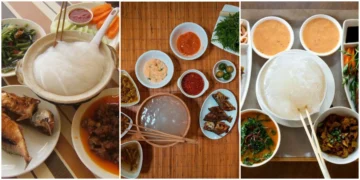Cape Verde Islands, an archipelago located off of West Africa in the central Atlantic Ocean, are famous for their vibrant Creole culture – an amalgamation of African, Portuguese, and other influences – and cuisine. Cachupa stands out as the best food of the Cape Verde Islands. Among their delicious food as the undisputed national dish – it stands as a testament to their history, resilience, and communal spirit; for generations, families have gathered around large pots of Cachupa enjoying its hearty flavors that epitomize Cape Verdean culture.
Why is Cachupa the Best Food of Cape Verde Islands?

Cachupa, Cape Verde’s signature dish, epitomizes both its culinary traditions and people and their ingenuity through resourcefulness. A soulful fusion of earthiness from hominy (dried maize kernels) and beans with meat or fish, tender vegetables, and spices creates an irresistibly delicious dish! Cachupa comes both as an irresistibly filling meat version (referred to as Cachupa Rica), or as an economical vegetarian variant (“Cachupa Pobre”); both versions have their own inherent versatility that adapts to what’s available or seasonal on its islands.
Cachupa is an inherently comforting dish. Served at family gatherings and festive occasions alike, its slow-cooked warmth brings people together. Cachupa also develops over time, becoming even tastier each time it is reheated the following day–an amazing feat that symbolizes both Cape Verdean cooking’s practical nature as well as their people’s resilience and adaptability.
Key Ingredients of Cachupa?
Cachupa’s beauty lies in its simplicity and use of local ingredients in perfect harmony:
- Hominy (Dried Maize Kernels): Cachupa begins with hominy as its starchy base ingredient. Hominy kernels must first be soaked overnight in warm water before simmering at low heat until their soft, almost creamy texture has been reached.
- Beans: Assorted types of beans–red kidney beans, black-eyed peas or any locally available legumes–provide essential protein, flavor and creaminess to your stew.
- Proteins: Cachupa has always been packed with a wide range of proteins. In “Cachupa Rica,” pork, beef, or goat meat may be mixed together; while coastal areas often prefer seafood as the protein source. This flexibility reflects both regional availability and historical influences.
- Vegetables: Seasonal vegetables such as sweet potatoes, squash, and occasionally cabbage or tomatoes are used to add natural sweetness and balance out the bold flavors in a stew dish.
- Aromatics and Spices: For an aromatic base, essential aromatics like garlic, onions, bay leaves, chili pepper flakes or black pepper add depth and complexity without overshadowing the dish.
- Olive Oil and Water or Stock: When making this dish, use only a minimal amount of olive oil for sauteing, then simmer in water or light broth so the flavors have time to come together over an extended cooking period.
Prepare Cachupa (Best Food of Cape Verde Islands)

- Soaking and Pre-Cooking the Grains and Beans: The process starts by soaking hominy and beans overnight to soften kernels and legumes while simultaneously shortening overall cooking times. In the morning, these ingredients should be rinsed thoroughly and placed into a large, heavy pot filled with fresh water before being brought up to boil and slowly simmered until their kernels and legumes begin softening.
- Sauteing Aromatics: In a separate large pot, heat a generous splash of olive oil on medium heat before sauteeing finely chopped onions and garlic until they soften, releasing their natural sweetness. Bay leaves and other selected spices are then added for an aromatic base that will infuse this dish with its distinctive savory notes.
- Once the aromatics are established, pieces of meat (or seafood in coastal recipes) should be lightly browned for extra flavor before hominy and beans are added along with seasonal vegetables like diced sweet potatoes or squash for texture enhancement and an earthy sweetness that complements its savory elements.
- Slow Simmering: Once combined, the ingredients are then simmered slowly for several hours to let all their flavors come together into an exquisite stew. Slow cooking allows hominy to break down slowly while beans release their starches to thicken the dish to perfection. Many chefs believe Cachupa tastes even better after some additional time has been allowed for flavor development!
What Makes Cachupa Stand Out?
Cachupa’s uniqueness lies in its great versatility and ability to represent Cape Verdean culture and society as a whole. While most stews adhere to one set formula, Cachupa is more like an ever-evolving dish that adjusts according to resources at hand: richer versions with multiple meats may be prepared at more affluent homes during festive occasions (Cachupa Rica), while simple meals might feature simpler versions with few ingredients (Cachupa Pobre). This dual nature enables this dish to change with its makers as seasons and fortunes do so as it evolves along the same lines.
The slow-cooking technique is one of the hallmarks of Cachupa’s character; not only does it soften ingredients into comforting textures, but it also develops depth of flavor only possible through hours of simmering. Furthermore, Cachupa’s ability to grow increasingly delicious over time–often served as leftovers that have been reheated–adds an element of nostalgia and communal enjoyment as families gather around a meal that continues to mature over time.
History of Cachupa (Best Food of Cape Verde Islands)

Cachupa’s origins trace back to the Cape Verdean settlement when inhabitants had to make do with locally available ingredients and limited resources. With influences drawn from both African culinary traditions and Portuguese colonial cuisine, Cachupa emerged as a hearty stew designed to provide sustenance during lean times – over centuries it evolved to be not only nutritionally dense, but also deeply symbolic; an epicenter for struggle, adaptation, and ultimately, survival.
Cachupa was traditionally prepared in large communal pots, creating a sense of unity and shared identity among families and villages. Cachupa became more than simply food – it became an act of celebration, witnessing resilience of Cape Verdean spirits. Now revered not just for its delicious taste but as an emblematic cultural practice from days long gone by that brought people together while sharing meals together or commemorating traditions on these islands.
Other Cape Verdean Cuisine
- Pasteis de Bacalhau: Succulent codfish fritters inspired by Portuguese cuisine are an irresistibly tasty appetizer or snack.
- Cuscus de Milho: An alternative corn couscous option served alongside stews and meat dishes.
- Lagostada: A seafood specialty featuring lobster prepared with local spices and served in an aromatic light sauce.
- Grogue: Cape Verdean culture features its distinct sugarcane spirit that’s an integral part of celebrations.
- Bolinhos de Mandioca: Cassava fritters are crispy on the outside but soft inside make for an exquisite way to experience.










Discussion about this post